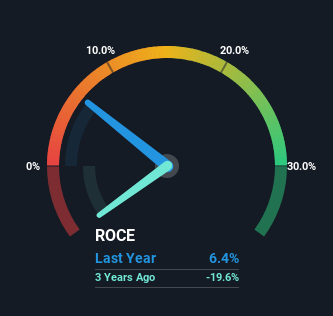- Australia
- /
- Oil and Gas
- /
- ASX:PVE
Investors Will Want Po Valley Energy's (ASX:PVE) Growth In ROCE To Persist

If we want to find a stock that could multiply over the long term, what are the underlying trends we should look for? In a perfect world, we'd like to see a company investing more capital into its business and ideally the returns earned from that capital are also increasing. Put simply, these types of businesses are compounding machines, meaning they are continually reinvesting their earnings at ever-higher rates of return. So when we looked at Po Valley Energy (ASX:PVE) and its trend of ROCE, we really liked what we saw.
Understanding Return On Capital Employed (ROCE)
For those who don't know, ROCE is a measure of a company's yearly pre-tax profit (its return), relative to the capital employed in the business. To calculate this metric for Po Valley Energy, this is the formula:
Return on Capital Employed = Earnings Before Interest and Tax (EBIT) ÷ (Total Assets - Current Liabilities)
0.064 = €941k ÷ (€15m - €326k) (Based on the trailing twelve months to December 2023).
Thus, Po Valley Energy has an ROCE of 6.4%. On its own, that's a low figure but it's around the 6.9% average generated by the Oil and Gas industry.
See our latest analysis for Po Valley Energy

Historical performance is a great place to start when researching a stock so above you can see the gauge for Po Valley Energy's ROCE against it's prior returns. If you're interested in investigating Po Valley Energy's past further, check out this free graph covering Po Valley Energy's past earnings, revenue and cash flow.
The Trend Of ROCE
The fact that Po Valley Energy is now generating some pre-tax profits from its prior investments is very encouraging. The company was generating losses five years ago, but now it's earning 6.4% which is a sight for sore eyes. In addition to that, Po Valley Energy is employing 104% more capital than previously which is expected of a company that's trying to break into profitability. This can indicate that there's plenty of opportunities to invest capital internally and at ever higher rates, both common traits of a multi-bagger.
On a related note, the company's ratio of current liabilities to total assets has decreased to 2.2%, which basically reduces it's funding from the likes of short-term creditors or suppliers. Therefore we can rest assured that the growth in ROCE is a result of the business' fundamental improvements, rather than a cooking class featuring this company's books.
The Bottom Line
Long story short, we're delighted to see that Po Valley Energy's reinvestment activities have paid off and the company is now profitable. And since the stock has fallen 40% over the last five years, there might be an opportunity here. That being the case, research into the company's current valuation metrics and future prospects seems fitting.
If you'd like to know more about Po Valley Energy, we've spotted 3 warning signs, and 1 of them can't be ignored.
While Po Valley Energy isn't earning the highest return, check out this free list of companies that are earning high returns on equity with solid balance sheets.
New: Manage All Your Stock Portfolios in One Place
We've created the ultimate portfolio companion for stock investors, and it's free.
• Connect an unlimited number of Portfolios and see your total in one currency
• Be alerted to new Warning Signs or Risks via email or mobile
• Track the Fair Value of your stocks
Have feedback on this article? Concerned about the content? Get in touch with us directly. Alternatively, email editorial-team (at) simplywallst.com.
This article by Simply Wall St is general in nature. We provide commentary based on historical data and analyst forecasts only using an unbiased methodology and our articles are not intended to be financial advice. It does not constitute a recommendation to buy or sell any stock, and does not take account of your objectives, or your financial situation. We aim to bring you long-term focused analysis driven by fundamental data. Note that our analysis may not factor in the latest price-sensitive company announcements or qualitative material. Simply Wall St has no position in any stocks mentioned.
Have feedback on this article? Concerned about the content? Get in touch with us directly. Alternatively, email editorial-team@simplywallst.com
About ASX:PVE
Po Valley Energy
Operates as a gas and condensate development company in the Po Valley Region, Italy.
Flawless balance sheet with acceptable track record.


